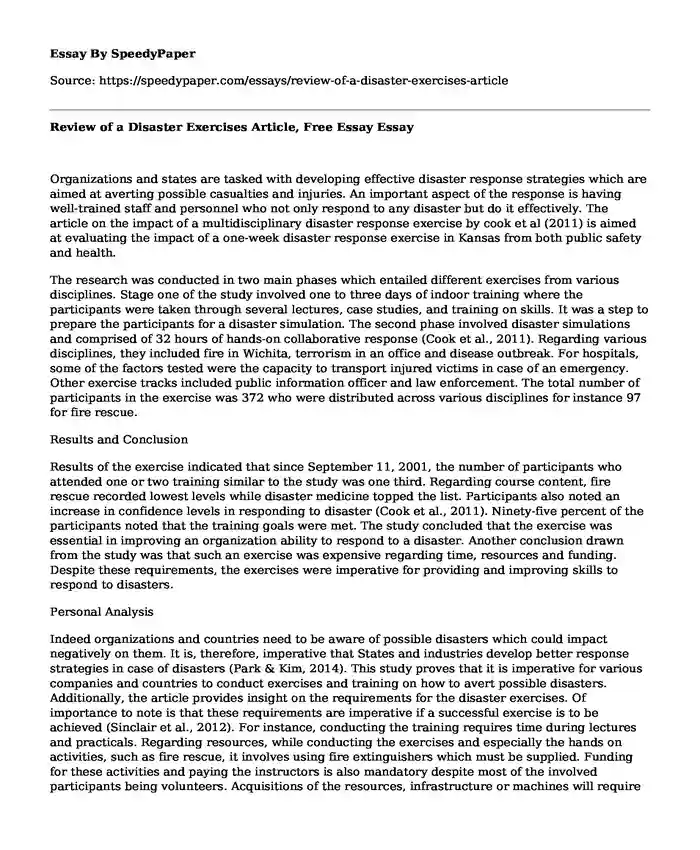
| Type of paper: | Essay |
| Categories: | Management Disaster |
| Pages: | 3 |
| Wordcount: | 665 words |
Organizations and states are tasked with developing effective disaster response strategies which are aimed at averting possible casualties and injuries. An important aspect of the response is having well-trained staff and personnel who not only respond to any disaster but do it effectively. The article on the impact of a multidisciplinary disaster response exercise by cook et al (2011) is aimed at evaluating the impact of a one-week disaster response exercise in Kansas from both public safety and health.
The research was conducted in two main phases which entailed different exercises from various disciplines. Stage one of the study involved one to three days of indoor training where the participants were taken through several lectures, case studies, and training on skills. It was a step to prepare the participants for a disaster simulation. The second phase involved disaster simulations and comprised of 32 hours of hands-on collaborative response (Cook et al., 2011). Regarding various disciplines, they included fire in Wichita, terrorism in an office and disease outbreak. For hospitals, some of the factors tested were the capacity to transport injured victims in case of an emergency. Other exercise tracks included public information officer and law enforcement. The total number of participants in the exercise was 372 who were distributed across various disciplines for instance 97 for fire rescue.
Results and Conclusion
Results of the exercise indicated that since September 11, 2001, the number of participants who attended one or two training similar to the study was one third. Regarding course content, fire rescue recorded lowest levels while disaster medicine topped the list. Participants also noted an increase in confidence levels in responding to disaster (Cook et al., 2011). Ninety-five percent of the participants noted that the training goals were met. The study concluded that the exercise was essential in improving an organization ability to respond to a disaster. Another conclusion drawn from the study was that such an exercise was expensive regarding time, resources and funding. Despite these requirements, the exercises were imperative for providing and improving skills to respond to disasters.
Personal Analysis
Indeed organizations and countries need to be aware of possible disasters which could impact negatively on them. It is, therefore, imperative that States and industries develop better response strategies in case of disasters (Park & Kim, 2014). This study proves that it is imperative for various companies and countries to conduct exercises and training on how to avert possible disasters. Additionally, the article provides insight on the requirements for the disaster exercises. Of importance to note is that these requirements are imperative if a successful exercise is to be achieved (Sinclair et al., 2012). For instance, conducting the training requires time during lectures and practicals. Regarding resources, while conducting the exercises and especially the hands on activities, such as fire rescue, it involves using fire extinguishers which must be supplied. Funding for these activities and paying the instructors is also mandatory despite most of the involved participants being volunteers. Acquisitions of the resources, infrastructure or machines will require monetary support. Through the study, I concur with it that exercises are essential in developing skills useful in disaster management.
In conclusion, disasters are a possibility in countries and organizations and are characterized by deaths and losses regarding infrastructure and other resources in case they occur. However, these effects can be mitigated by having an effective response team. Notably, the team requires advanced skills which are achieved through training in both theoretical and practical aspects. This is as ascertained by research on the impact of multidisciplinary disaster response exercises by Cook et al. (2011).
References
Cook, D. J., Nazir, N., Skalacki, M., Grube, C. D., Choi, W. S. (2011). Impact of a multidisciplinary disaster response exercise, Journal of Emergency Mnagement, 9(4), 35 - 43
Park, J., & Kim, Y. (2014). Overview and Issues of Disaster Management Training and Exercise Program for Local Government Officials. The Journal of the Korea Contents Association, 14(11), 702-712.
Sinclair, H., Doyle, E. E., Johnston, D. M., & Paton, D. (2012). Assessing emergency management training and exercises. Disaster Prevention and Management: An International Journal, 21(4), 507-521.
Cite this page
Review of a Disaster Exercises Article, Free Essay. (2019, Oct 28). Retrieved from https://speedypaper.net/essays/review-of-a-disaster-exercises-article
Request Removal
If you are the original author of this essay and no longer wish to have it published on the SpeedyPaper website, please click below to request its removal:
- Free Essay on How It Is Possible to Change the World of Communication
- Free Essay on the U.S. Military Operations, Battles, and Campaigns - Land, Sea, And Air
- Free Essay on How Popularity and Emotional Instability Influence Bullying
- English Composition Assignment: Victorian and Modernist Literature. Free Essay
- Essay Sample on Sonnet - To Science
- Essay Sample: External Forces in Play of Our Identities
- Essay Sample on Kendrick Lamar's Music Video
Popular categories




